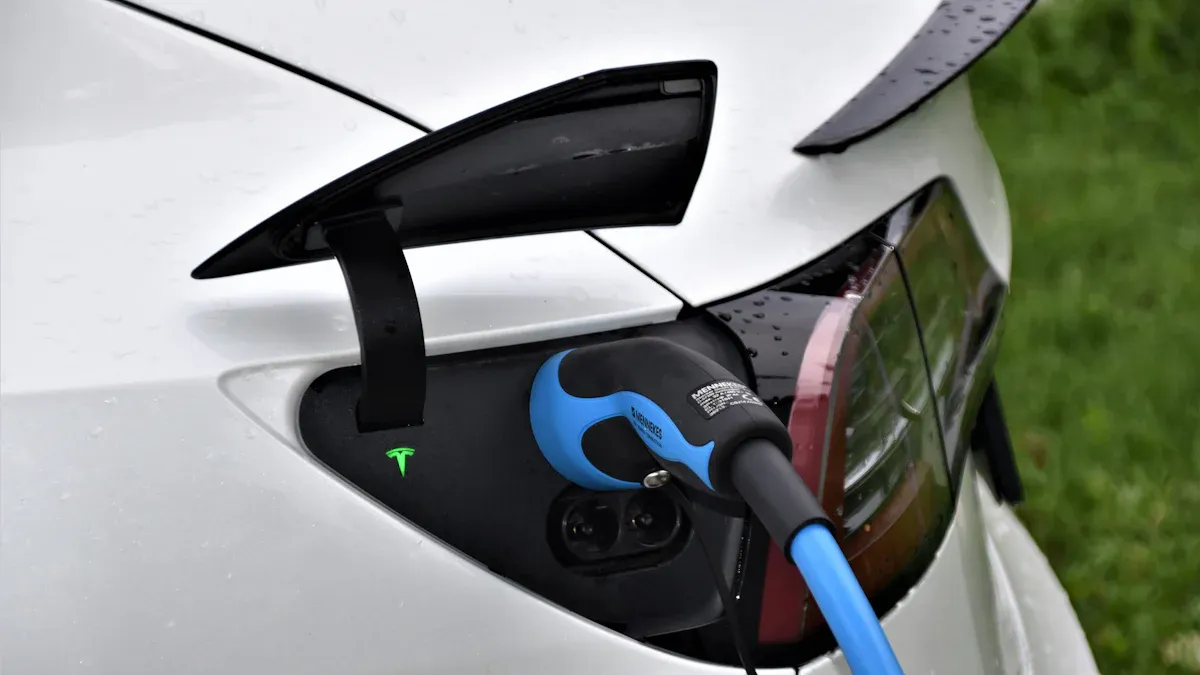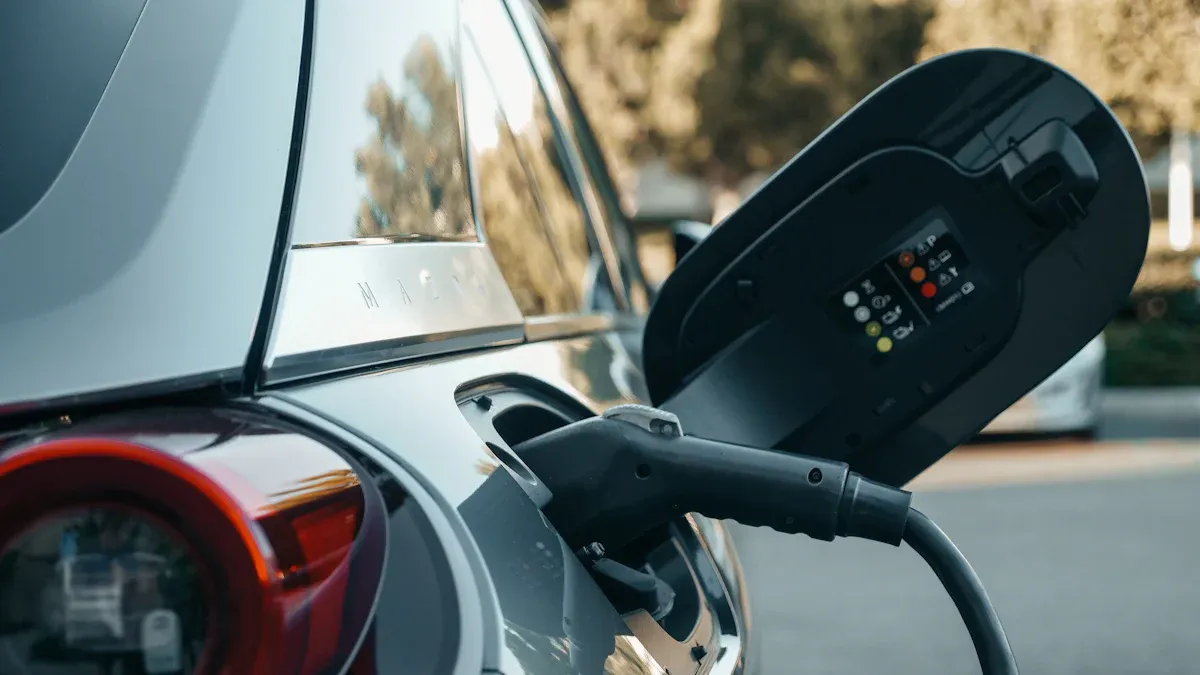
SiC Coatings are transforming the landscape of electric vehicle batteries. With their capability to boost performance while tackling heat management and durability issues, they are a game-changer. Advanced techniques such as CVD SIC COATING and TAC COATING further optimize battery efficiency, supporting faster charging and extended range. These cutting-edge innovations contribute to lightweight, durable systems that are crucial for the continued growth of the EV industry.
Key Takeaways
- SiC coatings help EV batteries stay cool and last longer.
- They make batteries more efficient, so cars go farther per charge.
- Using SiC coatings makes batteries lighter, improving cars and new designs.
Understanding SiC Coatings in EV Battery Manufacturing

What Are SiC Coatings?
SiC coatings, or silicon carbide coatings, are thin layers of silicon carbide applied to surfaces to enhance their properties. You’ll find these coatings used in industries where durability and heat resistance are critical. In EV battery manufacturing, SiC coatings act as a protective layer, improving the performance and lifespan of battery components.
SiC coatings are not just about protection; they also enable batteries to operate efficiently under extreme conditions.
Key Properties of SiC Coatings
Silicon carbide coatings offer unique properties that make them ideal for EV batteries. These include:
- High thermal conductivity: Helps dissipate heat quickly.
- Exceptional hardness: Resists wear and tear.
- Chemical stability: Prevents reactions that could degrade battery materials.
- Lightweight nature: Reduces the overall weight of battery systems.
These properties ensure that your EV battery remains reliable and efficient, even during demanding use.
Role of SiC Coatings in EV Batteries
SiC coatings play a vital role in enhancing battery performance. They improve thermal management, allowing batteries to stay cool during operation. This reduces the risk of overheating and extends battery life. By minimizing energy loss, SiC coatings also boost energy efficiency, ensuring that your EV can travel longer distances on a single charge. Additionally, their lightweight nature contributes to the development of compact and efficient battery systems, which are essential for modern electric vehicles.
Benefits of SiC Coatings
Enhanced Thermal Management
Efficient thermal management is critical for electric vehicle batteries. SiC coatings excel in this area by offering high thermal conductivity. This property allows heat to dissipate quickly, keeping battery components cool even during intense operation. When your battery stays within an optimal temperature range, it performs better and lasts longer.
Without proper heat management, batteries can overheat, leading to reduced efficiency and potential safety risks. SiC coatings help prevent these issues by acting as a thermal shield.
By maintaining a stable temperature, these coatings also reduce the need for bulky cooling systems. This makes your EV lighter and more energy-efficient, enhancing its overall performance.
Improved Energy Efficiency
SiC coatings minimize energy loss, ensuring that more power is directed toward driving your vehicle. Their chemical stability prevents unwanted reactions within the battery, which could otherwise lead to inefficiencies.
When energy is used more effectively, your EV can travel farther on a single charge. This improvement directly addresses one of the biggest concerns for EV owners: range anxiety. With SiC coatings, you can enjoy longer trips without constantly worrying about recharging.
Additionally, better energy efficiency means reduced charging times. You’ll spend less time at charging stations and more time on the road, making your EV experience more convenient.
Increased Durability and Longevity
Battery components face constant wear and tear, especially under demanding conditions. SiC coatings provide exceptional hardness, protecting these components from physical damage. This durability ensures that your battery remains reliable over time.
The chemical stability of SiC coatings also plays a role in extending battery life. By preventing corrosion and degradation, these coatings keep your battery functioning at its best for years.
A longer-lasting battery not only saves you money on replacements but also reduces environmental waste. Choosing SiC-coated batteries is a step toward sustainability.
Contribution to Lightweight Battery Systems
Weight is a crucial factor in EV design. Heavier batteries require more energy to move, reducing overall efficiency. SiC coatings contribute to lightweight battery systems by eliminating the need for additional protective layers.
Their inherent strength and stability allow manufacturers to use thinner materials without compromising performance. This reduction in weight improves your vehicle’s acceleration, handling, and energy consumption.
Lightweight batteries also open the door to innovative EV designs. With less weight to account for, manufacturers can focus on creating sleeker, more aerodynamic vehicles that appeal to modern consumers.
Challenges in SiC Coating Adoption
High Production Costs
SiC coatings offer incredible benefits, but their production remains expensive. Manufacturing these coatings requires advanced techniques like chemical vapor deposition (CVD), which demand specialized equipment and skilled labor. These factors drive up costs, making SiC coatings less accessible for widespread use.
High costs can limit adoption, especially for smaller manufacturers looking to compete in the EV market.
Reducing production expenses is essential for SiC coatings to become a standard in EV battery manufacturing. Innovations in manufacturing processes and material sourcing could help lower costs over time.
Scalability and Supply Chain Issues
Scaling up SiC coating production presents significant challenges. You may face difficulties in sourcing raw materials like silicon carbide, which are not always readily available. Supply chain disruptions can further complicate the process, delaying production timelines and increasing costs.
- Limited suppliers: Few companies specialize in producing high-quality SiC materials.
- Global demand: The growing EV market increases competition for these resources.
To overcome these hurdles, manufacturers need to invest in robust supply chain strategies and explore alternative sources for raw materials.
Technical Application Challenges
Applying SiC coatings to EV battery components requires precision. The process involves handling high temperatures and ensuring uniform coating thickness. If the application isn’t perfect, the coating may fail to deliver its intended benefits.
Technical challenges can lead to inefficiencies, reducing the overall performance of the battery.
You’ll need advanced tools and techniques to ensure consistent application. Training skilled technicians and refining coating methods are critical steps in addressing this issue.
Industry Adoption of SiC Coatings
Leading Manufacturers Using SiC Coatings
Several leading manufacturers have embraced SiC coatings to improve EV battery performance. Companies like Tesla and Panasonic have integrated these coatings into their battery designs to enhance efficiency and durability. Tesla, for instance, uses SiC-coated components in its advanced battery systems to optimize thermal management and extend battery life. Panasonic focuses on leveraging SiC coatings to reduce energy loss and improve charging speeds.
By adopting SiC coatings, these manufacturers set a benchmark for innovation in EV battery technology.
Other industry leaders, including LG Energy Solution and CATL, are also exploring SiC coatings to stay competitive in the rapidly evolving EV market. Their efforts highlight the growing importance of this technology in shaping the future of electric vehicles.
Case Studies in EV Battery Applications
Real-world applications of SiC coatings demonstrate their transformative impact on EV batteries. One notable case involves a partnership between a leading EV manufacturer and a materials science company. Together, they developed SiC-coated battery cells that achieved a 20% increase in energy efficiency and a 30% reduction in heat generation.
Another example comes from a European automaker that incorporated SiC coatings into its high-performance EV models. These vehicles now boast faster charging times and extended driving ranges, addressing key consumer concerns.
These case studies prove that SiC coatings are not just theoretical solutions but practical innovations driving measurable improvements in EV technology.
Trends in SiC Technology Adoption
The adoption of SiC coatings is accelerating as manufacturers recognize their benefits. You’ll notice a shift toward collaborative research and development, with companies partnering to refine application techniques and reduce costs. Governments and industry organizations are also investing in SiC technology to support sustainable transportation goals.
Emerging trends include the use of automated systems for precise coating application and the exploration of alternative materials to complement SiC coatings. These advancements aim to overcome current challenges and make SiC coatings more accessible to manufacturers worldwide.
As the EV market grows, SiC coatings will play a pivotal role in meeting consumer demands for efficient, durable, and eco-friendly vehicles.
Future of SiC Coatings in EV Batteries

Innovations in Application Techniques
You can expect significant advancements in how SiC coatings are applied to EV battery components. Researchers are exploring automated systems that ensure precise and uniform coating application. These systems reduce human error and improve the overall quality of the coatings. For example, robotic arms equipped with advanced sensors can apply SiC coatings with unmatched accuracy.
Another promising innovation involves low-temperature application methods. Traditional techniques like chemical vapor deposition (CVD) require high temperatures, which can limit their use. New methods aim to apply SiC coatings at lower temperatures, making the process more energy-efficient and compatible with a wider range of materials.
These innovations not only enhance the performance of SiC coatings but also make them more accessible to manufacturers.
Advancements in Cost Reduction
High production costs have been a major barrier to the widespread adoption of SiC coatings. However, ongoing research is addressing this challenge. One approach involves developing alternative materials that mimic the properties of silicon carbide but are less expensive to produce.
You’ll also see efforts to streamline the manufacturing process. For instance, companies are investing in scalable production techniques that reduce waste and improve efficiency. Bulk production of SiC coatings is becoming more feasible, thanks to these advancements.
Government funding and industry partnerships are further driving cost reduction. By pooling resources, stakeholders can accelerate the development of cost-effective solutions. These efforts aim to make SiC coatings a standard feature in EV battery manufacturing.
Market Trends and Projections
The market for SiC coatings is growing rapidly. Analysts predict a steady increase in demand as EV adoption continues to rise. You’ll notice a shift toward integrating SiC coatings into mainstream battery designs, driven by their proven benefits in performance and durability.
Emerging markets in Asia and Europe are leading the charge. These regions are investing heavily in EV infrastructure and sustainable technologies. As a result, the demand for SiC coatings is expected to surge.
According to industry reports, the global market for SiC coatings could double within the next decade.
Collaborative efforts between manufacturers and research institutions are shaping the future of this technology. These partnerships focus on innovation and scalability, ensuring that SiC coatings remain at the forefront of EV battery advancements.
Impact on Next-Generation EV Batteries
SiC coatings are set to revolutionize next-generation EV batteries. Their ability to enhance thermal management and energy efficiency will enable the development of ultra-fast charging batteries. Imagine charging your EV in minutes instead of hours.
These coatings also pave the way for solid-state batteries, which are considered the future of EV technology. Solid-state batteries offer higher energy density and improved safety. SiC coatings play a crucial role in protecting these advanced batteries from wear and tear.
By integrating SiC coatings, manufacturers can create batteries that are lighter, more durable, and capable of delivering longer ranges.
The environmental impact of EV batteries will also improve. Longer-lasting batteries mean fewer replacements, reducing waste and conserving resources. SiC coatings contribute to a more sustainable future for electric vehicles.
SiC coatings drive the evolution of EV batteries by improving efficiency, durability, and performance. You’ll see their adoption grow as innovations reduce costs and improve scalability.
SiC coatings will shape the future of EV technology, enabling longer ranges, faster charging, and sustainable battery systems. Their impact will define the next generation of electric vehicles.
FAQ
What makes SiC coatings better than traditional materials?
SiC coatings offer superior thermal conductivity, chemical stability, and durability. These properties improve battery performance, extend lifespan, and reduce energy loss compared to traditional materials.
Are SiC coatings environmentally friendly?
Yes, SiC coatings enhance battery longevity, reducing waste and the need for frequent replacements. This contributes to a more sustainable and eco-friendly electric vehicle ecosystem.
Can SiC coatings work with all types of EV batteries?
SiC coatings are compatible with most battery types, including lithium-ion and solid-state batteries. Their adaptability makes them a versatile solution for various EV technologies.


